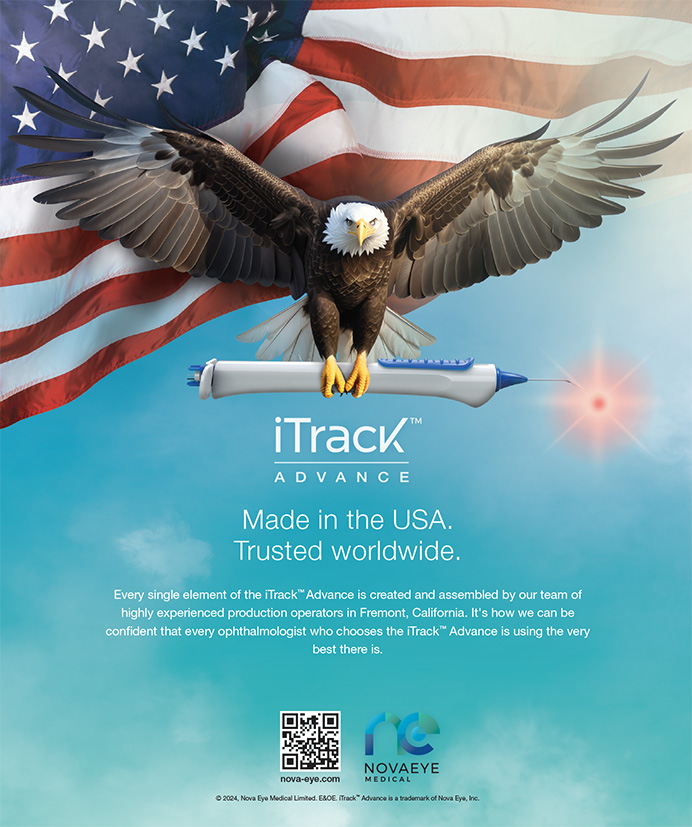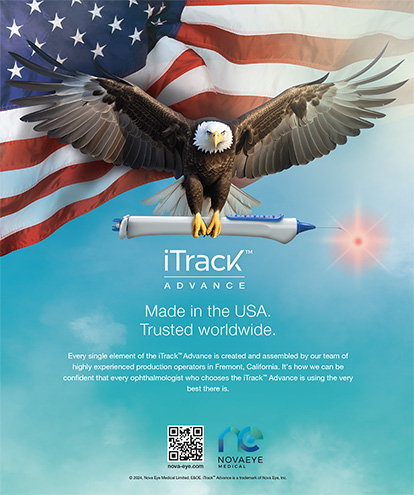One method by which to obtain a multifocal or bifocal effect is classically called the bull's eye or the center-surround optical system. In this process, the patient uses the peripheral part of the optic for distance, and a small, round, central optic, placed with a plus power of usually +3.0 or +4.0 D, for near vision. Physicians have previously used this technology in contact lenses and IOLs. The concept of the small-diameter intracorneal lens utilizes the cornea and a small hydrogel implant to create a center-surround bifocal for presbyopic patients. It is a potential treatment for the 100 to 110 million presbyopes in the US and also works in the pseudophakic eye.
HOW IT WORKS
The lens is made out of hefilcon A, which is a 45% water hydrogel. It is 0.06 mm thick and 2 to 2.2 mm in diameter and has a diopter range of +1.5 to +3.5. In emmetropic patients, who lack any meaningful refractive error at distance, the surgeon places a small 2- to 2.2-mm hydrogel implant (+3.0 to +4.0 D) onto the center of their cornea, directly over the pupil. This implant essentially turns the cornea into a center-surround bifocal. Patients are able to read by focusing through the center of their pupil, and they can see at distance by focusing through their normal peripheral cornea (Figure 1).
SURGICAL TECHNIQUE
The surgery is fairly simple. The patient looks at the operating light, and the surgeon marks the center of the cornea. He then makes a small RK mark in the precise center of the pupil before making an incision that is approximately 500 µm deep and 1 mm inside the limbus. The surgeon then uses a paufique lamellar dissector (a type of corneal lamellar dissector) to dissect into the center of the cornea to a depth of 2.5 µm. To insert the IOL, he places it on the end of the dissector and centers it as perfectly under the pupil as possible. There is no suture closure, and the surgery takes approximately 5 minutes.
BACKGROUND
Approximately 6 or 7 years ago, Chiron, which was acquired by Bausch & Lomb Surgical (San Dimas, CA), funded a study for a small series of patients utilizing this surgical concept. The surgeons involved in the original study were Daniel S. Durrie, MD; Dick Keats, MD; Graham Barrett, MD; Roberto Zaldivar, MD; and I. We each implanted a small number of these lenses between July 1994 and July 1996 for a total of approximately 20 implantations. Fifteen of the implants were peformed in my patients, and recently my colleagues and I decided to conduct a 5-year follow-up study, the results of which I presented at the June 2002 ASCRS meeting in Philadelphia. Of my 15 patients, eight returned for the 5-year follow-up examination.
FOLLOW-UP RESULTS
We concluded that the patients were functioning very well. In the original study, we implanted the lens in the nondominant eye and did not operate on the dominant eye. This approach of using a multifocal intracorneal lens in the nondominant eye is called modified monovision, a method also used with contact lenses and IOLs. Six of the eight patients were functioning well without using glasses at all, including distance or reading glasses. Two of the eight patients were using reading glasses some of the time but could read normally sized print without correction.
Of the 15 patients who received implants, four did not achieve a good result and had the lens explanted. Those four patients all returned to their preoperative states. In the eight patients who returned for the 5-year follow-up, the mean visual acuity was 20/25 at distance and J2 at near. All of the eight patients were happy; six of the eight never wore glasses, one wore glasses most of the time, and one wore them occasionally. The exact acuities were as follows: two patients were 20/20 and J1, one patient was 20/20 and J2, one was 20/25 and J1, one was 20/25 and J2, one was 20/25 and J3, one was 20/30 and J2, and one was 20/40 and J2. All the patients were 20/40 or better and J3 or better, which is a reasonable result with multifocal optics. Five of the patients were phakic, three were pseudophakic, and the visual acuity results were the same in both the phakic and the pseudophakic eyes.
OBSERVATIONS
Hydrogels have a fairly long history of being placed in the cornea, and as you may know, Anamed, Inc. (Lake Forest, CA), is working on a hydrogel corneal lens for hyperopia. The material of the small-diameter intracorneal inlay was well tolerated without any discolor-ation or pigmentary deposits, and the inlay worked well in both the phakic and pseudophakic patients. Patients experienced a mild loss of distance BCVA; preoperatively, the patients were 20/20, and the median postoperative distance acuity was only 20/25. However, the near acuity improved on average from J9 preoperatively to J2 postoperatively. In other words, the patients lost one line at distance but gained seven lines at near. No patient complained of halos, which are a potential side effect of multifocal optics; however, one patient described a mild ghosting of vision.
POTENTIAL RISKS
The risks of this procedure are the same as for any astigmatic keratotomy. The most severe risk is infection, which the surgeon would treat using postoperative antibiotics. The most common risk of the procedure is placing the lens in a decentered fashion, and if this occurs, the lens may not function. The most surprising result of our study was that some patients did not seem to receive the full benefit of the lens that we expected, and therefore did not have a good result compared to the other eight patients who experienced a positive result with the lens.
THE LATEST DEVELOPMENTS
The small-diameter intracorneal inlay is a novel, po-tential approach for treating presbyopia in select pa-tients. The surgical technique is straightforward, quite safe, and also reversible. When Chiron transitioned into Bausch & Lomb Surgical, this project was postponed. Recently, Bausch & Lomb Surgical sent some of their scientists to independently review my 5-year follow-up data. Based on what they found, they are preparing to resurrect the corneal inlay study to further examine this concept. Currently, this lens would require an investigational device exemption, and it is not inside a study at this time. I feel that the technology is a great idea.
Richard L. Lindstrom, MD, serves as the managing partner of Minnesota Eye Consultants, P.A., in Minneapolis, Minnesota, and as a clinical professor of ophthalmology at the University of Minnesota. He holds a financial interest in the technology mentioned herein and is a consultant for Bausch & Lomb Surgical. Dr. Lindstrom may be reached at (612) 813-3600; info@mneye.com.


